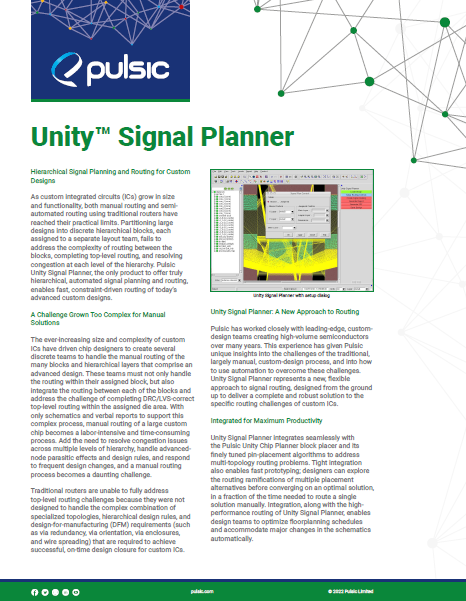Unity Signal Planner
Comprehensive custom signal planning and routing solution
Benefits
- Fast, reliable, full-chip hierarchical signal planning and top-level routing capabilities produce the best results in the shortest time.
- Made-for-custom technology supports unique custom design needs and gives optimal results for custom designs, without the struggle to adapt ASIC tools.
- Access to early parasitics (SPF) for critical path simulations.
- Support for complex routing topologies.
- Guided flows give designers the full benefit of Pulsic advanced technology and productivity with minimal training
- Complete integration maximizes productivity by eliminating data translation issues
Key Features
- High performance
- Constraint-driven routing
- Fast prototyping
- Intelligent net sorting to avoid crossing routes and minimize noise
- Specialized routing topologies to deliver optimum routing pattern
- Via optimization technology for compact routing and maximum yield
Full-chip signal planning
Custom design size and complexity continue to increase dramatically, whilst design teams are spending ever more time and resources completing floorplans and DRC-correct top-level routing. Although powerful ASIC tools exist for these tasks, they were not made for custom, analog, or mixed-signal designs. They also lack the configurability required for such tasks as bus/repeater-cell planning and insertion or DRC/LVS top-level routing. Because these digital-centric tools are often only available as an expensive total package, they are impractical for design teams that only require a few of the pieces of that package.




High-Performance routing with support for complex topologies
Unity Signal Planner routes thousands of nets in minutes, rather than days, enabling it to handle the complex top-level and block routing challenges of advanced custom ICs. It produces a Manhattan routing style to avoid jogs, reducing the number of vias required, and minimizing wire length. Minimizing wire length reduces parasitic effects and thus power consumption and signal-timing delays. Nets are sorted optimally during routing to avoid crossing routes, which in turn, reduces noise. Users can define constraints for the router, such as net metal width, shielding requirements, maximum and minimum layer width, and signal-pair matching. It delivers optimizations for bus routing and compact signal routing leveraging unique via optimization technology to correctly align multi-cut preferred-rule vias that enable more compact routing and die-area savings.
This powerful combination of features enables designers to route hierarchically complex custom chips in a fraction of the time required using manual, or even semi-automated, routing approaches. The automated signal planning and routing process provided by Unity Signal Planner is consistent, repeatable, and accommodates inevitable last-minute design changes quickly and easily.
Unity Signal Planner Datasheet
Enter your details below to download the datasheet. Immediate download.


